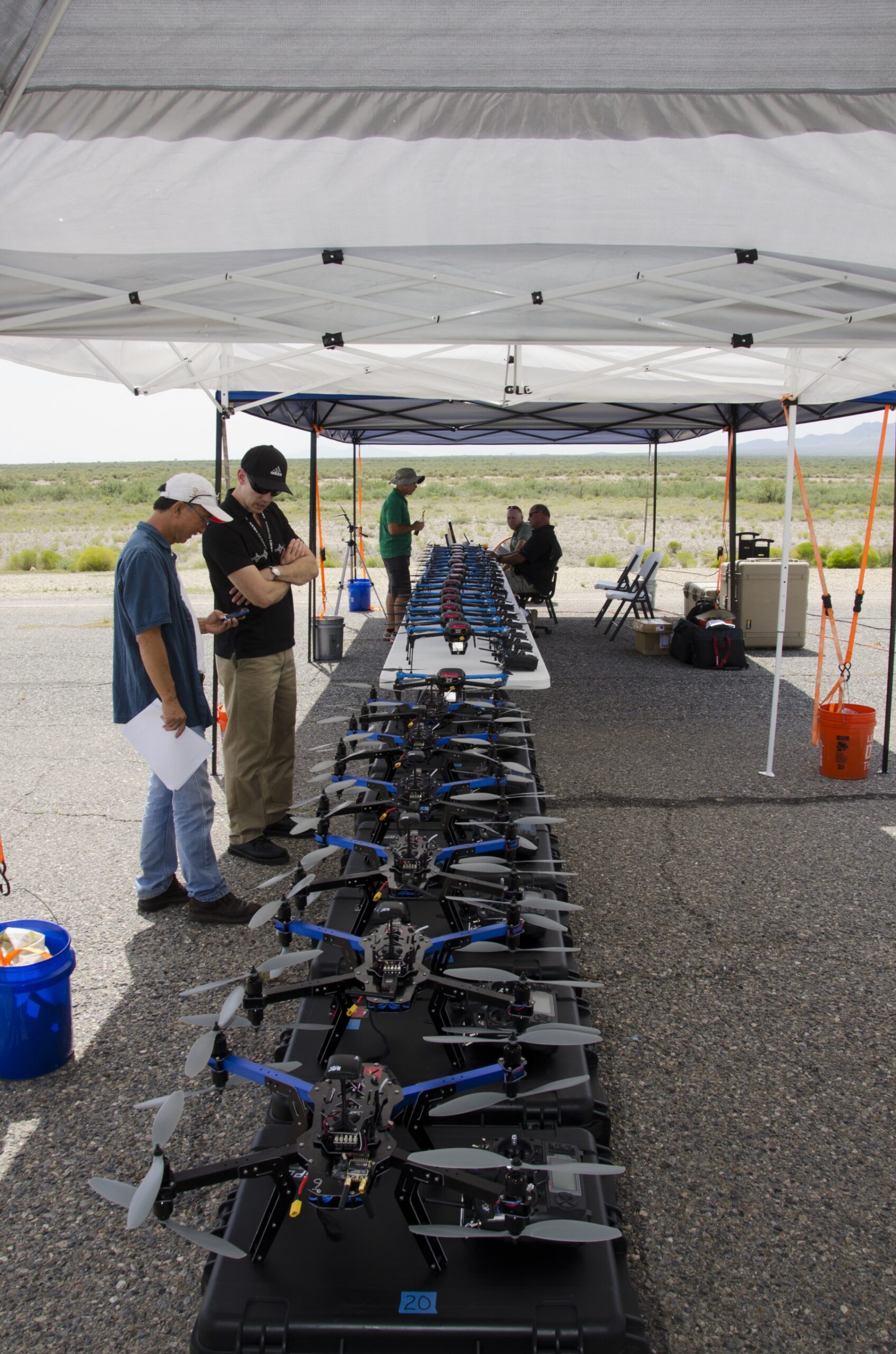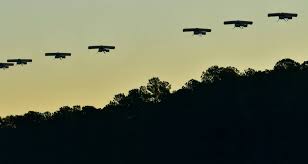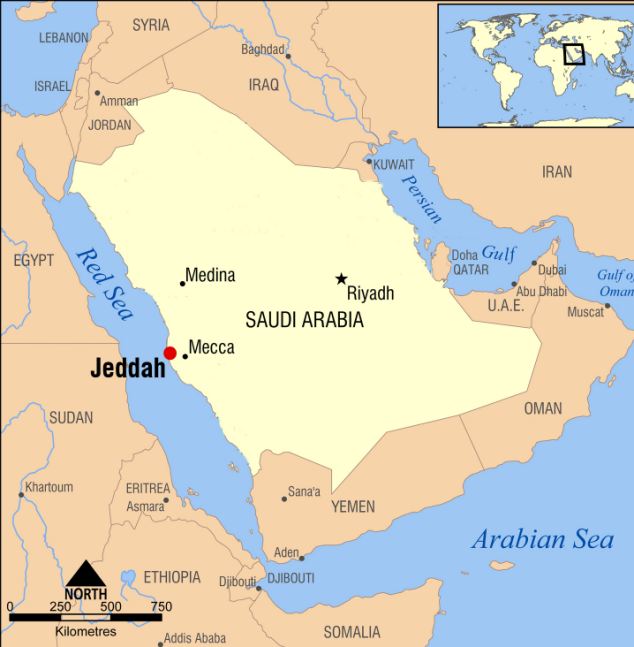Part 2 of 2 Parts (Please read Part 1 first)
Drone swarm technology could enhance or diminish the success of nuclear delivery systems depending on how they are deployed by either attacker or defender. The idea of mutually assured destruction (MAD) has been the basis of nuclear strategy for decades. In order for MAD to be successful, a nuclear first strike must be survivable by the victim so that the victim can successfully retaliate.
Nuclear threats are less credible if a potential victim is confident that they can defeat an incoming nuclear attack. If an aggressor believes that their nuclear weapons systems can be defeated by a potential enemy, they might be inclined to develop and deploy more sophisticated nuclear delivery systems. They could also act more aggressively in potential conflicts. Such issues are the basis of Russia concerns about U.S. ballistic missile defense system proposals. These same issues are also the reason for the development of the triad of nuclear warhead delivery systems.
It is an open question whether drone swarms will be more successful for nuclear offense or nuclear defense. From a purely theoretical point of view, new technologies that can be used to counter nuclear warhead delivery systems would be more disruptive to the balance of nuclear weapons than technologies which merely improved the delivery of nuclear warheads. Nuclear weapons are already capable of horrendous damage. This makes it is unlikely that any improvements in delivery systems and destructive capability of nuclear weapons would result in any major change to planning for nuclear warfare.
North Korea only has primitive nuclear weapons and delivery systems and yet they already pose a significant threat to the U.S. Minor improvements in N.K. nuclear arsenal and delivery systems would have little impact on U.S. concerns and planning for potential attacks by N.K. Ultimately, while drone swarms might improve nuclear attacks, they will probably be more useful for nuclear defense.
It is inevitable that sophisticated drone swarm defense systems will coevolve with drone swarm technology. The major vulnerability of drone swarms lies in their need for reliable communication to coordinate their activities. If those communications can be jammed or hijacked, then the swarm would fall apart into a cloud of individual drones that would be easier to deal with. Powerful encryption systems will be needed to avoid the compromise of drone to drone communication. More powerful transmitters and more sensitive receivers will be needed to overcome jamming. This means that drones will have to be heavier with greater power systems. This will increase the cost of the swarms.
Offensive drones will need to be more powerful with much longer ranges than defensive drones. They will have to fly over enemy territory and evade defenses that will be developed to be used against enemy drone swarms. They will have to carry more fuel, munitions and counter measures that defensive drones over friendly territory will not need. This will require that they be bigger and heavier than defensive drones. This will make them more vulnerable to enemy drone defenses.
It is inevitable that drone swarms will soon be used for both offense and defense. There will be rapid development of such drones as technologies compete and developments leapfrog each other. Time will tell whether or not drones swarms prove themselves in battle.
Blog
-

Nuclear Weapons 374 – Drone Swarms And Nuclear Warfare – Part 2 of 2 Parts
-

Geiger Readings for Feb 15, 2019
Ambient office = 126 nanosieverts per hour
Ambient outside = 93 nanosieverts per hour
Soil exposed to rain water = 93 nanosieverts per hour
Red bell pepper from Central Market = 105 nanosieverts per hour
Tap water = 116 nanosieverts per hour
Filter water = 107 nanosieverts per hour
-

Nuclear Weapons 373 – Drone Swarms And Nuclear Warfare – Part 1 of 2 Parts
Part 1 of 2 Parts
This is the age of the drone. From the size of insects to cargo hauling drones, these unmanned vehicles are exploding in variety and utility. Going beyond single drones, a lot of work is being poured into the creation of drone swarms which can work cooperatively. By definition, drone swarms are “multiple unmanned platforms and/or weapons deployed to accomplish a shared objective, with the platforms and/or weapons autonomously altering their behavior based on communication with one another.”
Today, I am going to focus on the use of drone swarms for military purposes. Drone swarms could be used for the delivery of different types of weapons including chemical, biological, radiological and/or nuclear. Such drones could travel in the air, on the land or in water to deliver deadly payloads. This blog will be about the use of drone swarms for nuclear offense and defense.
Drone swarms could serve as a new kind of nuclear missile defense system. They could even thwart hypersonic missiles currently being advertised as unstoppable. Swarms composed of thousands of cheap simple drones could be used to form defensive domes over high valued targets. Incoming missiles could be damaged or deflected by individual drones.
The same type of drone swarm could be used to form an aerial mine field, exploding on contact with nuclear bombers flying to targets. Even small drones could damage the wings and/or engines of aircraft. Low flying bombers hugging the terrain to avoid radar would be especially vulnerable to such air mines. In addition, short range drones could be used because they would need to cover less territory. Swarms of aerial, surface or submerged drones could be used to hunt for, follow, or even attack nuclear submarines.
Drones swarms could also be used for delivery of nuclear warheads. Research into such drone swarms is already being carried out by nuclear armed nations. They could also assist nuclear warhead delivery without needing to actually carry nuclear warheads themselves. Drone swarms could be used to confuse, disable or totally defeat the defense systems of enemies. Some missile defense systems are on mobile platforms and drone swarms are well suited to spread out and search broad areas for them. Drones could also masquerade as enemy aircraft to confuse and overwhelm air defense systems. Swarms of drones would be able to carry out coordinated maneuvers just like a fleet of aircraft to enhance the illusion.
It is possible that drone swarms could also assist in the targeting of nuclear warheads. Swarms of drones could be sent into enemy airspace to identify targets and gather information about defense system. Swarm principles could be applied to cruise missiles to allow them to coordinate to attack targets and avoid defenses. This would be particularly useful in what is known as counterforce strikes against military installation of an enemy. Such attacks require highly accurate and comprehensive identification of targets and precise strikes against such targets. Improving targeting is not as important for retaliatory strikes which deliberately target cities and civilians. More accurate targeting also means that less warheads and delivery systems are needed which reduces costs.
Please read Part 2 -

Geiger Readings for Feb 14, 2019
Ambient office = 100 nanosieverts per hour
Ambient outside = 130 nanosieverts per hour
Soil exposed to rain water = 130 nanosieverts per hour
Blueberry from Central Market = 122 nanosieverts per hour
Tap water = 110 nanosieverts per hour
Filter water = 99 nanosieverts per hour
-

Nuclear Reactors 656 – Why Saudi Arabia Should Not Get U.S. Help To Build Nuclear Power Reactors
Saudi Arabia in very interested in purchasing nuclear power reactors. They say that they want to use nuclear power internally so they can export more of their oil for export profits. Major suppliers of nuclear technology around the world are in discussion with Saudi Arabia about supplying those desired reactors.
The U.S. is no exception. U.S. nuclear companies want the Saudi contracts. There have been negotiations between the U.S. Energy and State Department and Saudi Arabia about making a deal involving U.S. companies. Unfortunately, there have been problems because the U.S. wants assurances that Saudi Arabia will not use U.S. nuclear technology to develop nuclear weapons and Saudi Arabia does not want to give those assurances.
Apparently, there were plans kept from public view for the U.S. and Russia to supply not just Saudi Arabia but other Middle Eastern countries with nuclear power plants Those secret plans were revealed during the investigation of Russian involvement in manipulating the 2016 U.S. Presidential election. Members of Trump’s inner circle had drawn up a comprehensive and complex plan to build and installed nuclear power reactors across the Middle East. The U.S. and Russia were supposed to supply the fuel for these plants and remove the spent nuclear fuel. Ultimately, the plan was abandoned. There has been speculation that Trump and/or others close to him may have had a financial interest in the plan.
It has been widely reported that Saudi Arabia is interested in obtaining nuclear weapons, especially if Iran is developing them. There are even reports that Pakistan actually has a standing order for nuclear warheads for Saudi Arabia if and when they want them delivered. Whether or not these reports and speculations are true, if Saudi Arabia obtains nuclear power reactors, other Middle Eastern Arab countries might take that as a sign that Saudi Arabia is working on nuclear weapons and a Middle Eastern nuclear arms race might be triggered.
Turkey is not an Arab country but it is a major player in the Middle East. Israel has nuclear weapons and is at odds with Turkey. If it looks like Saudi Arabia and Iran are developing nuclear weapons, it is a given that Turkey will want them too.
If a nuclear arms race starts up in the Middle East, it might not stay confined to that region. To the east, Pakistan and India are two nuclear powers in a tense standoff with each other. They have already fought several wars and the next one might involve nuclear weapons. Then there is China further east which has hundreds of nuclear weapons. If Saudi Arabia, Iran and Turkey acquire nuclear weapons, that would mean that there would be a corridor of nuclear armed nations from the Mediterranean Sea to the Pacific Ocean. Perhaps African nations and even South American nations might be caught up in a race to develop nuclear weapons.
Aside from the involvement of the U.S. government in building nuclear power reactors in Saudi Arabia, a number of U.S. corporations would be involved in the actual transfer to nuclear technology to the Middle East. Can these corporations be trusted to closely monitor the nuclear technology they supply to prevent any application of that technology to weapons development by Saudi
Arabia? Or would their greed overcome their better judgement and cause them to turn a blind eye to a Saudi nuclear weapons program?
It would probably be best for the world if Saudi Arabia did not obtain nuclear power reactors while the current regime holds power there. And, in any case, it would definitely be best for the U.S. not to be involved in building nuclear power reactors in Saudi Arabia. -

Geiger Readings for Feb 13, 2019
Ambient office = 128 nanosieverts per hour
Ambient outside = 135 nanosieverts per hour
Soil exposed to rain water = 137 nanosieverts per hour
Bartlett pear from Central Market = 89 nanosieverts per hour
Tap water = 59 nanosieverts per hour
Filter water = 54 nanosieverts per hour
-

Radioactive Waste 380 – NRC Says That Howard University Violate Rules Pertaining To Storage Of Radioactive Materials
Howard University was founded in 1867. It is a private research university composed of thirteen schools and colleges. It is located in northwest Washington, D.C. two miles from the U.S. capitol.
Last year, the university notified the U.S. Nuclear Regulatory Commission (NRC) that radioactive powder had been discovered in a small lidded jar in an unused physics lab. The jar was stored in a lead shielded container that was labeled as a storage unit for radioactive materials. The powder had been stored in the locked physics lab since at least 2014. A label on the jar said that the material had been received by the university in 1942.
The letter to the NRC said that the scientist who had last used the lab had retired in 2014. There is no information about how the powder came to Howard or whether the scientist made any use of it. The letter did not say that anyone had been exposed to the radioactive powder in the jar. The university did say that no one was harmed by the powder.
Investigators from the NRC found that the powder was actinium-227 which is a radioactive isotope. About eighty microcuries of actinium was found in the jar. A microcurie is one millionths of a curie which is a unit used to measure radioactivity. A letter from the NRC summarizing their findings said that the university was never authorized to be in possession of the radioactive material.
There was no evidence that the lab had suffered any contamination by the actinium. The NRC said that the university had failed to store the actinium in a ventilated hood or other containment device that would have prevented any from escaping into the air in the lab. The NRC said that if the actinium had been mishandled, someone could have received an unintended internal radiological dose.
The NRC decided that Howard had been responsible for a Severity Level III incident. The NRC categorizes radiological incidents into four different levels of severity with Level One being the most severe. Howard could have been fined up to seven thousand dollars for the violation. However, the NRC did not fine Howard because the university had taken “prompt and comprehensive” steps to deal with the problem.
Anthony Wutoh is the Howard Provost. He said, “Our priority remains the safety of our entire campus community. Once a potential risk was identified, the University adhered to all policies and best practices to assure the safety of our students, faculty and staff.”
The letter from the NRC was addressed to Wayne A.I. Frederick. It mentioned that the university had issued an order to the chairs of all academic departments to carry out an inventory of all radioactive materials in their labs to confirm that they do not have any unauthorized materials.
In 2008, there was an incident at Howard related to their handling of cesium-137, another radioactive isotope. In 2015, the NRC decided that Howard had violated safety rules with regard to the cesium incident in 2008. Last year, Idaho State University was fined eight thousand five hundred dollars for failing to properly maintain control and surveillance of one gram of plutonium.
